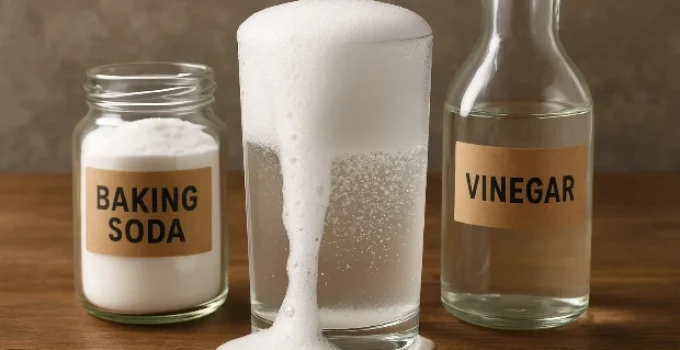⛏️Break It Down
- What Are Baking Soda and Vinegar?
- What Happens If You Mix Baking Soda and Vinegar?
- Why Does It Fizz and Foam?
- Real-World Uses of This Reaction
- Can You Change the Reaction?
- 🎯 Final Thoughts
- 📚 References
What Are Baking Soda and Vinegar?
Baking soda is a chemical called sodium bicarbonate (NaHCO₃). It’s a base, meaning it can react with acids.
Vinegar is a weak acid made mostly of acetic acid (CH₃COOH) and water.
These two common household items are safe, but when they mix, they create a surprising reaction!
| Ingredient | Type | Chemical Name |
|---|---|---|
| Baking Soda | Base | Sodium Bicarbonate (NaHCO₃) |
| Vinegar | Acid | Acetic Acid (CH₃COOH) |
🧂 According to the Royal Society of Chemistry, acids and bases react to neutralize each other, often creating gas and water.
What Happens If You Mix Baking Soda and Vinegar?
When baking soda and vinegar are mixed, a chemical reaction takes place. Here’s what happens:
- The acetic acid reacts with the sodium bicarbonate.
- This forms carbonic acid, which immediately breaks down.
- It releases carbon dioxide (CO₂) gas, causing bubbling and fizzing.
- The leftover liquid contains water and sodium acetate.
This reaction looks like this:
NaHCO₃ + CH₃COOH → CO₂ + H₂O + CH₃COONa
💨 The fizz you see is carbon dioxide gas escaping! According to Science Buddies, this simple acid-base reaction can create enough pressure to blow the top off a plastic bottle.
Why Does It Fizz and Foam?
The fizzing happens because of the rapid release of CO₂ gas. As the gas tries to escape the liquid, it forms bubbles. If the reaction is trapped in a container, the gas builds up pressure—leading to an explosion or a messy eruption!
- Fizz = carbon dioxide bubbles forming fast
- Foam = gas mixed with liquid and any added dish soap or thickener
🌡️ According to American Chemical Society experiments, this gas production is similar to the gas you release when you exhale—CO₂ from your lungs!
Real-World Uses of This Reaction
This may seem like a fun science fair trick, but the baking soda and vinegar reaction has real uses:
- Cleaning drains: The fizz can loosen clogs.
- Deodorizing: CO₂ and the base help remove smells.
- Science experiments: Great for studying gas production, chemical change, and reaction rates.
- Inflating balloons: The gas can blow up a balloon without air.
| Use | Description |
|---|---|
| Cleaning | Bubbles scrub away grime in sinks and tubs |
| Experiments | Teaches acid-base reactions safely |
| Balloon Inflation | CO₂ fills balloons instead of breath |
🧽 According to the Environmental Protection Agency, baking soda and vinegar can be used for safe, eco-friendly household cleaning.
Can You Change the Reaction?
Yes! You can change the speed, amount, or force of the reaction by adjusting:
- Temperature: Warmer vinegar reacts faster.
- Concentration: Stronger vinegar creates more fizz.
- Amount: More baking soda means more gas—up to a point.
- Container shape: A narrow neck bottle makes a stronger blast.
⚗️ According to Exploratorium Science Snacks, changing the amounts of baking soda or vinegar lets you explore chemical reaction rates and limits.
🎯 Final Thoughts
Mixing baking soda and vinegar might look like a fun foam volcano—but it’s actually real chemistry at work! This simple experiment shows how acids and bases interact, how gases are formed, and how matter changes. It’s safe, exciting, and full of learning. Next time you watch it fizz, you’ll know exactly why.
📚 References
Royal Society of Chemistry. (n.d.). “Neutralising an Acid Solution.” https://edu.rsc.org/experiments/neutralising-an-acidic-solution/1756.article
Science Buddies. (n.d.). “Launching Homemade Baking Soda Rockets.” https://www.sciencebuddies.org/stem-activities/rockets-baking-soda
American Chemical Society. (n.d.). “K-8 Chemistry Resources.” https://www.acs.org/content/acs/en/education/resources/k-8.html
Environmental Protection Agency. (n.d.). “Safer Choice Cleaning Tips.” https://www.epa.gov/saferchoice
Exploratorium. (n.d.). “Wait Weight Don’t Tell.” https://www.exploratorium.edu/snacks/wait-weight-dont-tell-me
